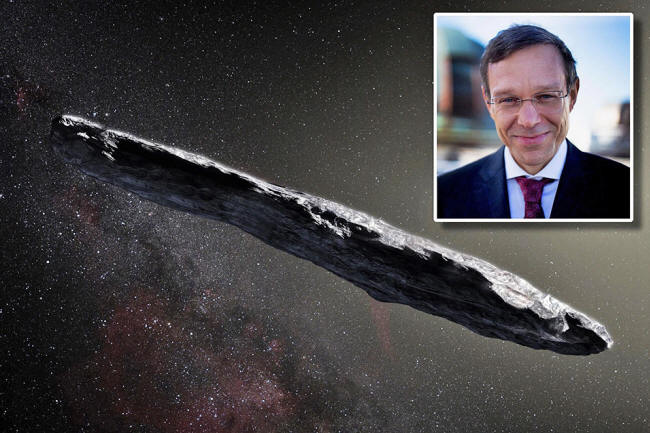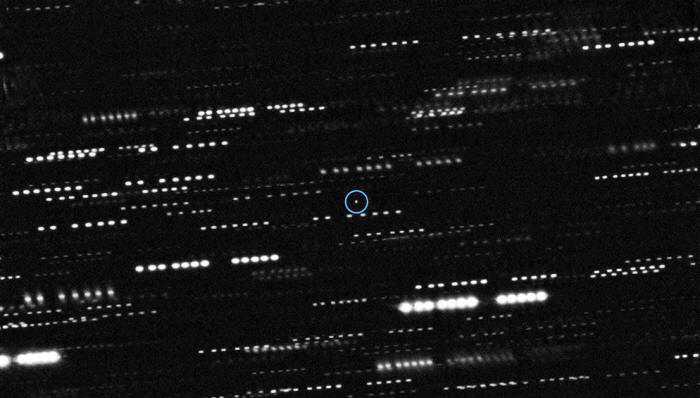|

by Vicky Verma
October 27,
2022
from
HowAndWhys Website
Spanish
version

In 2018, Professor
Avi
Loeb announced that the asteroid
'Oumuamua,
is of interstellar origin
and is probably an alien spaceship...
This news caused a huge
scandal in the scientific community.
The man who spent almost a
decade as Chair of Harvard's Department of Astronomy was not taken
seriously and was ridiculed.
However, more than four
years later, he continues to claim that his hypothesis is based on
solid evidence and has not been refuted by anyone. And he calls to
start looking for similar objects in the Universe.
In 2017, Canadian astronomer Robert Weryk noticed 'Oumuamua
from the Haleakala Observatory, Hawaii, using
Pan-STARRS1, when it
passed the Earth.
Scientists had no clue
about the composition of this object because it was totally
different from other asteroids as it was elongated and sparkling.
At
first, scientists thought it was a comet, but it did not have a gas
tail.
As the research began, it
started becoming even more mysterious.
After studying this data, professor Loeb put forward an extremely
bold hypothesis along with his
colleague Shmuel Bailey in 2018, saying,
"'Oumuamua was
produced by an
alien civilization."
He said that perhaps this
was a part of a larger spacecraft drifting in interstellar space.
The same year, Mr. Loeb hypothesized that there is a possibility of
the
existence of quadrillion alien spacecraft
alone in our solar system.
"There should be one
in every volume roughly the size of the orbit of the Earth
around the sun.
This is a vast area
in human terms, but in the immensity of space, it's pretty
small. So it means that there are plenty of them, a quadrillion
of them, inside the Oort cloud. Inside the solar system.
There are lots of
them," he explained.
Now in 2022, Mr. Loeb
enhanced his thoughts, asking a logical question:
How many more
'Oumuamuas might there be in the solar system and its
neighborhood?
Loeb and Carson Ezell,
both Harvard astronomers, reached this conclusion in a recent study
(The
Inferred Abundance of Interstellar Objects of Technological Origin) published in September 2022 but has not yet undergone peer review.
They estimate that there
could be as many as 4,000,000,000,000,000,000 (or 4 quintillion)
'Oumuamuas-like objects.

Marked with a blue circle,
‘'Oumuamua
appears as a faint dot
in
the center of this image.'
Credit:
ESO and K. Meech et al.
The smaller figure, 4 quintillion, refers to extraterrestrial bodies
that appear to be directed for the solar system's "habitable zone,"
closer to our Sun.
That's where Earth
orbits, and where astronomers have some chance of spotting a passing
object...
Mr. Loeb does not claim that the Milky Way is swarming with
quintillions of alien spacecraft.
He has not stated that,
"'Oumuamua is a
crewed
craft or a robotic probe...",
...he has only suggested
that we should be open to the idea.
In their research, they detect first four known interstellar objects
over the past decade:
The rate of detection of
interstellar objects depends on detection sensitivity, given the
objects' size and distance.
Therefore, the population of alien craft is not what Loeb and Ezell
estimated. It is the population of potential artificial objects or
alien craft.
They write:
"One can use recent
rates of detection of interstellar objects and known
capabilities to estimate the density of similar objects in the
solar neighborhood and the total number of such objects bound by
the thin disk of the Milky Way."
In order to determine how
many further objects similar to 'Oumuamua, that may be out there in
the darkness, having traveled from a nearby star system, Loeb and
Ezell took into account how little of the galaxy we can observe with
our instruments - which is not much.
They actually came up with two numbers. One for all interstellar
objects, including those that are zipping randomly around and across
the solar system and are not likely to pass within view of our
instruments.
That is a staggering,
40,000,000,000,000,000,000,000,000,000,000,000 (or 40 decillion).
Research on
Extraterrestrial spacecraft
Professor Avi Loeb is one of the highly qualified persons that adds
credibility to
UFO research.
He assures that his
Galileo Project will have transparency in sharing its progress with
the public and nothing will be classified.
He states that by 2023,
the Galileo Project will publish all its data on natural,
artificial, and extraterrestrial objects.
The announcement of the Galileo Project came shortly after the
Pentagon made public its UFO footages in 2021.
At the time, Dr. Loeb
said:
"What we see in our
sky is not something that politicians or military personnel
should interpret, because they were not trained as scientists,
it's for the science community to figure out."
Dr. Loeb believed that
the discovery of equipment from extraterrestrial civilizations would
have a profound impact on humanity.
His
Galileo Project will
search for such relics near Earth.
In his recent interview with Curt Jaimungal from TOE, Dr.
Loeb confirmed that the Galileo Project began testing a suite of
instruments that would observe that sky and analyze the data with
artificial intelligence algorithms.
He further stated that,
"hopefully by 2023,
we'll start collecting data at places where there are reports on
these [UAP] objects.
That's the third
branch of the Galileo projects, we're already doing this
research and we should see it's a phishing Expedition."
On November 10, 2021, Dr.
Loeb attended The Ignatius Forum at the Washington National
Cathedral along with Jeff Bezos, Bill Nelson, and
Avril Haines, the Director of National Intelligence.
He had an opportunity to
ask Haines about her thoughts on the nature of UAPs, to which she
unhesitatingly replied that she does not know.
The Harvard professor is not pleased with the government's work on
the phenomena and urges scientists to engage in these activities.
"Because the sky is
not classified, it's only the sensors that the government is
using that are classified and that's why the data is classified.
So the Galileo
Project will try to establish a data stream that is open to the
public, the way science is done.
Everyone will be able
to access the data and it will be of high quality."
In January 2021, Dr. Loeb
released the book "Extraterrestrial - The First Sign of Intelligent
Life Beyond Earth."
In it, he doubles
down on his statements of 'Oumuamua as an artificial
extraterrestrial object...
In June, he explicitly
connected his 'Oumuamua hypothesis to the burgeoning government
investigations into unidentified aerial phenomena in a Scientific
American opinion column.
The
Vera C. Rubin Observatory, which is
being built in Chile, was also mentioned by Loeb.
The observatory, which is
scheduled to open in 2023, should be able to examine the entirety of
the southern sky every four days due to its 3.2 billion-pixel
camera.
According to Loeb, a
high-resolution photograph may show bolts and screws on an
artificial object's surface and tell it apart from a nitrogen
iceberg, a hydrogen iceberg, or a dust bunny.
|



